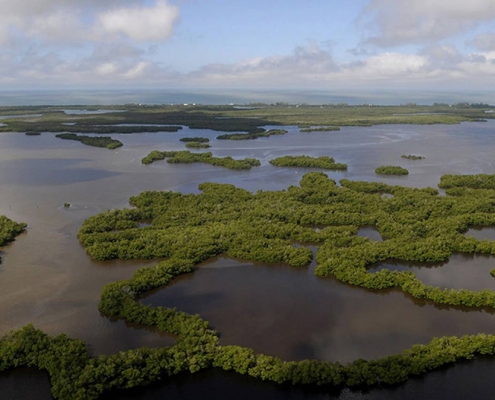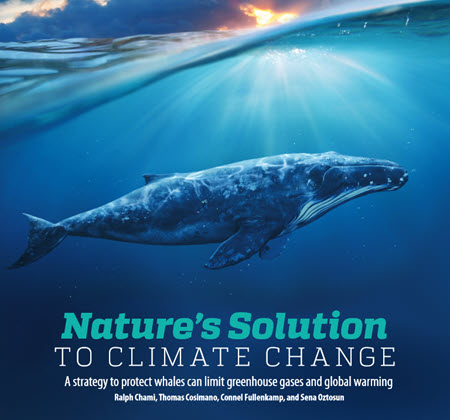How to Restore the Planet for Free

The estuaries around the Everglades, nursery grounds for fish and other species, suffer from changes in the natural hydrology due to development, agriculture and other human-caused factors. (Photo: Florida Department of Environmental Protection)
I recently came upon a 20-year-old relic: The transcript of my testimony to Congress in 2000. I was making a pretty big ask of the Committee — actually an unprecedented ask — all the while trying to maintain my composure and accurately recite the remarks that so many of my extraordinary colleagues had helped me write. The ask? To spend billions of taxpayer dollars over decades on the largest and most expensive environmental restoration project ever attempted in history: The restoration of the Everglades.
We were overjoyed when Congress (and the Florida Legislature, which would share the cost), in a remarkable example of bipartisanship, said “yes,” launching the replumbing, reengineering and reimagining of a massive ecosystem running from the rivers and streams near Disney World to the coral reefs of the Florida Keys. The project strives to restore the slow-moving sheetflow of water, the lifeblood of this unusual wetland, and ensure it is once again free of contamination and flows to the right place, in the right quantity, at the right time.
If ever there were an ecosystem that exemplifies how land and sea are inextricably linked, it’s the Everglades. The estuaries into which the Everglades’ slow-moving waters empty are the critical nursery grounds for important species of fish, many of great commercial importance. An estuary’s health depends upon a very delicate balance of fresh and saltwater. Development in the Everglades ecosystem and the alteration of the natural flows of water have caused untold damage to these estuaries, and in turn, to Florida’s beloved ocean life.
More than 20 years later, four of my graduate students, for their major assignment in my Ocean Stewardship and Sustainability class at Johns Hopkins University, Advanced Academic Programs had an idea. What if we could restore the Western Everglades (near Naples, Florida), bring back the health of its estuaries, create green infrastructure that could naturally prevent flooding and enhance coastal protection from ever-worsening storms. And as if that weren’t good enough, what if we could do it all for free? Better yet, what if restoring the Everglades could be profitable, perhaps offering investors a return on investment?

The Ocean Doctor family is growing! Our two interns working on environmental economics and restoration of the Western Everglades are Christina Riemer (Left) and MJ Hendren (Right). The project was born of their class project as graduate students at Johns Hopkins University, Advanced Academic Programs. (Christina and MJ join two other new Ocean Doctor interns focused on protecting the critically endangered sawfish.)
 The idea was inspired in part by friend and colleague Dr. Ralph Chami, Assistant Director for Institute for Capacity Development at the International Monetary Fund (IMF) and advisor to the organization, Blue Green Future, where I also serve as an advisor. He kindly gave a guest lecture to my class and the students were riveted. His landmark paper released by the IMF, Nature’s Solution to Climate Change, turned heads. It turns out that whales (or more specifically, their poop) play a significant role in sequestering carbon from the atmosphere by fertilizing the oceans and stimulating plankton growth. Considering how many whales once roamed and pooped in our seas before their devastation by humans, the carbon numbers were significant. The paper shows that the value of an individual whale today is in the millions of dollars, considering only carbon. The paper brought into focus the concept that natural carbon sequestration is not just about trees, mangroves and seagrasses. It’s also about wildlife, including whales and elephants.
The idea was inspired in part by friend and colleague Dr. Ralph Chami, Assistant Director for Institute for Capacity Development at the International Monetary Fund (IMF) and advisor to the organization, Blue Green Future, where I also serve as an advisor. He kindly gave a guest lecture to my class and the students were riveted. His landmark paper released by the IMF, Nature’s Solution to Climate Change, turned heads. It turns out that whales (or more specifically, their poop) play a significant role in sequestering carbon from the atmosphere by fertilizing the oceans and stimulating plankton growth. Considering how many whales once roamed and pooped in our seas before their devastation by humans, the carbon numbers were significant. The paper shows that the value of an individual whale today is in the millions of dollars, considering only carbon. The paper brought into focus the concept that natural carbon sequestration is not just about trees, mangroves and seagrasses. It’s also about wildlife, including whales and elephants.
Restoration in the Western Everglades will sequester carbon and that’s worth money in a rapidly-developing and increasingly lucrative carbon market. Selling carbon credits is not new. In the early ’90s I worked on a project examining the potential of offsetting U.S. power plant emissions in Siberian forests.
But today things are different. People like Dr. Chami have helped bring this type of work to a new level. Thirty years ago there was little focus on wildlife. The methods to ensure a carbon sequestration project is measurable and credible are more sophisticated. There is more demand for “carbon credits” today as more and more corporations, like Amazon, commit to becoming carbon neutral. A more mature and organized carbon market exists today, with rapidly rising prices that make more carbon sequestration projects economically feasible. And compared to the early ’90s, there is a greater sense of urgency as recognition of the impacts of climate change has become more widespread and ambitious global commitments must be met.
In addition to carbon, the tools of environmental economics let us place a value on the other “services” that restoring and preserving the natural environment provide. In the case of the Western Everglades, this includes flood control, coastal protection, healthier estuaries and fish and other wildlife populations, tourism, etc.
[pullquote]The environment is not free. The cost of inaction is not zero.[/pullquote]I can’t help but think that this approach has the potential to change our traditional thinking about caring for our ecosystems. Restoration is no longer an expense — it’s an investment. And it’s potentially an investment that can put real money into the pockets of investors. It is our hope to use this pilot project to demonstrate that we may — by example — be able to mollify the divisive environmental debates that are inevitably peppered with arguments claiming that environmental protection is simply too costly. By pointing out the value of our ecosystems, environmental economics can ensure that there are dollars on the other side of the ledger. The environment is not free. The cost of inaction is not zero.
 Finally, many of us doing conservation work find environmental economics essential in helping us to understand how valuable our ecosystems are to us, sometimes in unexpected ways. Yet at the same time, we often find it frustrating that we must bring our pleas to protect Mother Earth into the arena of economics at all. Surely the ethics of protecting our only home should be enough. Of course, we have seen all too well that such arguments carry little weight, whether in County Commission meetings or Congressional hearings. I hope that changes and I think, bit by bit, it is.
Finally, many of us doing conservation work find environmental economics essential in helping us to understand how valuable our ecosystems are to us, sometimes in unexpected ways. Yet at the same time, we often find it frustrating that we must bring our pleas to protect Mother Earth into the arena of economics at all. Surely the ethics of protecting our only home should be enough. Of course, we have seen all too well that such arguments carry little weight, whether in County Commission meetings or Congressional hearings. I hope that changes and I think, bit by bit, it is.
Today we celebrate Earth Day, a time to reflect on this miraculous planet’s value — whether we measure it in dollars or in joy.




